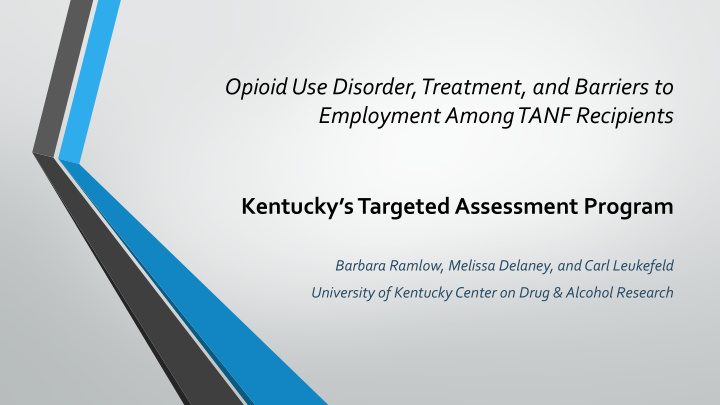



Opioid Use Disorder, Treatment, and Barriers to Employment Among TANF Recipients Kentucky’s Targeted Assessment Program Barbara Ramlow, Melissa Delaney, and Carl Leukefeld University of Kentucky Center on Drug & Alcohol Research
Kentucky’s Targeted Assessment Program (TAP) • Implemented through partnership with the Kentucky Cabinet for Health and Family Services, Department for Community-Based Services • Supported with Temporary Assistance for Needy Families funds to assist parents involved in Kentucky’s public assistance and child welfare systems within federally mandated timeframes PON2 736 1600001997 1
Purpose of TAP • To identify & address barriers to self-sufficiency, family stability, & safety: • Substance Use (SU) • Mental Health (MH) • Intimate Partner Violence (IPV) • Learning Problems (LP) • Basic Needs
TAP participant story “Sandy”
Barriers to employment • Estimates of drug & alcohol use disorders are almost double those for individuals who receive TANF • Women receiving TANF with substance use disorders report co-occurring depression, anxiety, and high levels of post-traumatic stress disorder (PTSD) • Studies have shown intimate partner violence to be higher among women receiving TANF than other low-income women not receiving TANF • Mental health problems have been found to be more prevalent in this population, as have Adverse Childhood Experiences (ACE) and adult trauma
Barriers to employment • Surveys of TANF caseloads in three states estimated that 20-50% of women have some type of learning problem and 20-25% have IQs of less than 80 • Unmet basic needs have been strongly correlated with mental health and intimate partner violence • The presence of multiple barriers continues to be the strongest predictor of non-participation in work activities and continues to be linked to poor employment among low-income parents
Percent of TAP participants assessed with mental health, substance use, intimate partner violence, learning problems barriers in FY 2017 (n=2,237)
Percent of TAP participants reporting unmet basic needs in FY 2017 (n=2,237)
Percent of TAP participants (n=12,191) self- reporting opioid use at baseline assessment in lifetime (FY 2012 through FY 2016)
Targeted Assessment Program (TAP) • 58 Targeted Assessment Specialists co-located in Department of Community-Based Services (DCBS) offices in 35 Kentucky counties • Referrals from child welfare and public assistance agencies
Key Practices • Co-location of TAP staff with DCBS staff • Holistic assessment of barriers & strengths • Strengths-based engagement, pre-treatment, & case management • Customized service plan created with the participant in consultation with the DCBS referring worker
Key Practices • Motivational interviewing & pretreatment to increase treatment effectiveness • Assistance with basic needs barriers • Ongoing follow-up with participants, referral source, and community partners (including job readiness programs, community services sites, employers) • Consultation & training • Advocacy • Multi-agency participation and collaboration at local, regional, & state level
TAP Outcomes FY 2017 “countable” work activity by TAP participants • Two-thirds (65%) of terminating assessed TAP participants enrolled in the Kentucky Works Program participated in a countable work activity within 6 months of TAP assessment • The average amount of time to enrollment in a countable work activity was 7 weeks
TAP Outcomes TAP Follow-up Study (Leukefeld et al., 2012) • There were statistically significant decreases from baseline to 6-month follow-up (n=322) for: • Mental health symptoms • Substance use • IPV • Percentage of participants with an open child welfare case • Percentage of participants experiencing work difficulty • Reliance on TANF decreased while employment increased
At 6-month follow-up (n=322), the percent of participants with assessed barriers significantly decreased
Participants also reported significant decreases in unmet basic needs at 6-month follow-up (n=322)
Participants reported significant changes in employment-related outcomes at 6-month follow- up (n=322)
Participants reported significant decreases in welfare receipt and child welfare involvement at 6-month follow-up (n=322)
Kentucky’s TAP Sites
References Delaney, M. & Leukefeld, C., TAP Baseline Opioid Use Data: 2012-2016, Report for the Kentucky Cabinet for Health and Family Services Opioid Task Force, December 19, 2016. Leukefeld, C., Carlton, E., Staton-Tindall, M., & Delaney, M. Six-Month Follow-Up Changes for TANF-Eligible Clients Involved in Kentucky’s Targeted Assessment Program. Journal of Social Service Research, 00:1-16, 2012 Ellerbe, T., Carlton, E., Ramlow, B., Leukefeld, C., Delaney, M., & Staton-Tindall, M. Helping low- income mothers overcome multiple barriers to self-sufficiency: Strategies and implications for human services professionals. Families in Society, 92(3), 289-294, 2011.
Contact Information Barbara Ramlow, Director Targeted Assessment Program University of Kentucky Center on Drug & Alcohol Research 643 Maxwelton Court Lexington, KY 40508 (859) 257-5971 barbara.ramlow@uky.edu
Contact Information Carl Leukefeld Professor and Principal Investigator Targeted Assessment Program University of Kentucky 111 College of Medicine Office Building Lexington, KY 40536 (859) 323-5308 cleukef@email.uky.edu
Recommend
More recommend